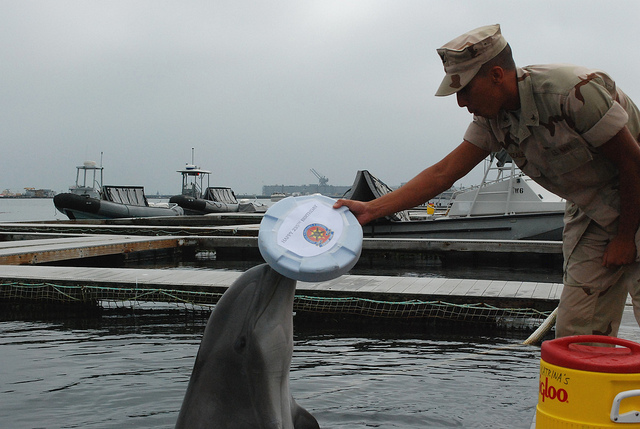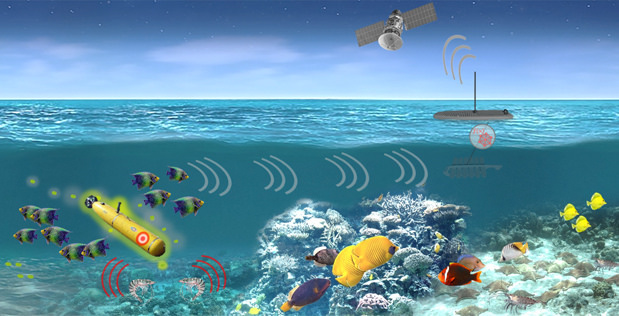The Pentagon’s Scary Plan to Militarize Ocean Life
ANGLO AMERICA, MILITARISM, ENVIRONMENT, ANIMAL RIGHTS - VEGETARIANISM, 2 Apr 2018
Maia Danks | Earth Island Journal – TRANSCEND Media Service
The US military plans to use ocean critters, including transgenic ones, as underwater spies.

A U.S. Navy marine mammal handler and a bottlenose dolphin who has been trained to detect explosives at a Naval base in California. Though DARPA has said it won’t use intelligent mammals and endangered species for the project, the claim is suspect given the U.S. Navy’s use of dolphins and sea lions to detect underwater mines. Lt. David Bennett / U.S. Navy
23 Mar 2018 – The U.S. military has plans to create genetically modified marine organisms that can be used as underwater spies for the military. Fantastic as this idea may seem, the Pentagon’s research arm, the Defense Advanced Research Projects Agency (DARPA), has actually launched a new program that aims to tap into the “natural sensing capabilities” of marine organisms, which are highly attuned to their surroundings, to track enemy traffic undersea.
The project out of DARPA’s Biological Technologies Office, called the Persistent Aquatic Living Sensors (PALS) program hopes to use everything from bacteria to large fish to find underwater vehicles by recording the creatures’ natural reactions to these vehicles and sending the data to an outside base.
A recent press release about the program said it would “study natural and modified organisms (emphasis added) to determine which ones could best support sensor systems that detect the movement of manned and unmanned underwater vehicles.”
“Beyond sheer ubiquity, sensor systems built around living organisms would offer a number of advantages over hardware alone,” the release said, explaining the program’s reasoning. “Sea life adapts and responds to its environment, and it self-replicates and self-sustains. Evolution has given marine organisms the ability to sense stimuli across domains—tactile, electrical, acoustic, magnetic, chemical and optical. Even extreme low light is not an obstacle to organisms that have evolved to hunt and evade in the dark.”
The program is currently seeking proposals that would help capture the responses of marine organisms—both natural and transgenic—to the presence of underwater vehicles, interpret those responses and relay them to a network of hardware devices.
It is unclear right now as to how this will happen. DARPA has stated that “intelligent mammals” and endangered species will not be used in the experiments or in the program itself, but it has been vague as to how it defines “intelligent mammals.” Questions as to the involvement of dolphins and other marine mammals arise, particularly since the U.S. Navy, is notorious for holding nearly 100 dolphins captive in San Diego, conducting experiments on them and using them for military purposes.

PALS concept art. Though the program states that it won’t use transgenic organisms without appropriate environmental safeguards, it’s highly likely that a GM marine organism, if released into the ocean, will interbreed with a regular one of its kind. Photo courtesy of DARPA
Though the program states that if any modified organisms are used it would require “appropriate environmental safeguards to support future deployment,” it is highly likely that a genetically modified marine organism released into the ocean will interbreed with an organism of the same (or similar) species whose genes hadn’t been tinkered with. And as the animals breed with each other, they will cause more and more of their kind to adopt the genetically modified traits. With time, the entire ocean could be filled with GM creatures and that could lead to changes in marine ecosystems that we can’t even begin to anticipate.
DARPA has said it would create and test modified species strictly in “contained, biosecure facilities.” But as this VICE report points out, “to actually deploy modified species, the military would have to release them into the wild, where they could drive out, outeat, or outbreed unmodified species.”
Another worry with genetically modified sea creatures is the likelihood that humans will consume them. With the amount of fishing and by-catch that currently happens around the world, it is inevitable that many people will end up consuming the GM animals. (While there has been no conclusive evidence linking GM food to negative health impacts, concerns remain that GMOs may cause yet unknown genetic changes, allergies or other serious harm to human health.)
These concerns apart, forcing these creatures to be spies for the U.S. military is inherently, morally wrong. No animal should be a tool for the military. Animals should not be treated as objects that can be altered and used for their natural gifts. They should be valued for what they are, and for being a part of ocean ecosystems.
It is clear that DARPA needs to stop this program. As the creators of the program, it has the ability to discontinue it and place its resources and abilities in more beneficial areas of technology. It needs to understand that the repercussions of a program like this will affect more than just the military; it will hurt the ocean, its creatures and the people who depend on it.
________________________________________________________
Related Articles:
- S. Military Is World’s Biggest Polluter ›
- S. Air Force Is Spraying 6 Million Acres With Chemicals in … ›
- Climate change revealed this U.S. military secret | Popular Science ›
- Climate change threatens half of U.S. military sites: Pentagon ›
Maia Danks is an intern at the International Marine Mammal Project. A senior at Berkeley High School, she’s interested in animal conservation, especially marine conservation, is a certified scuba diver, and loves to travel to see animals around the world. She’s also a ceramic artist, and founded Octopus Ceramics.
Go to Original – earthisland.org
DISCLAIMER: The statements, views and opinions expressed in pieces republished here are solely those of the authors and do not necessarily represent those of TMS. In accordance with title 17 U.S.C. section 107, this material is distributed without profit to those who have expressed a prior interest in receiving the included information for research and educational purposes. TMS has no affiliation whatsoever with the originator of this article nor is TMS endorsed or sponsored by the originator. “GO TO ORIGINAL” links are provided as a convenience to our readers and allow for verification of authenticity. However, as originating pages are often updated by their originating host sites, the versions posted may not match the versions our readers view when clicking the “GO TO ORIGINAL” links. This site contains copyrighted material the use of which has not always been specifically authorized by the copyright owner. We are making such material available in our efforts to advance understanding of environmental, political, human rights, economic, democracy, scientific, and social justice issues, etc. We believe this constitutes a ‘fair use’ of any such copyrighted material as provided for in section 107 of the US Copyright Law. In accordance with Title 17 U.S.C. Section 107, the material on this site is distributed without profit to those who have expressed a prior interest in receiving the included information for research and educational purposes. For more information go to: http://www.law.cornell.edu/uscode/17/107.shtml. If you wish to use copyrighted material from this site for purposes of your own that go beyond ‘fair use’, you must obtain permission from the copyright owner.
Read more
Click here to go to the current weekly digest or pick another article:
ANGLO AMERICA:
- Washington Green-Lights $30M for Gaza Aid Scheme Tied to Mass Killings of Palestinians
- War with Iran: We Are Opening Pandora's Box
- Trump’s Useful Idiots
MILITARISM:
- The Transatlantic Split Myth: How U.S.-Europe Militarization Thrives behind the Rhetoric
- Mapping Militarism 2025
- The Limitations of Military Might
ENVIRONMENT:
- Climate Misinformation Turning Crisis into Catastrophe, Report Says
- Megadroughts Are on the Rise Worldwide
- Fire Weather
ANIMAL RIGHTS - VEGETARIANISM: